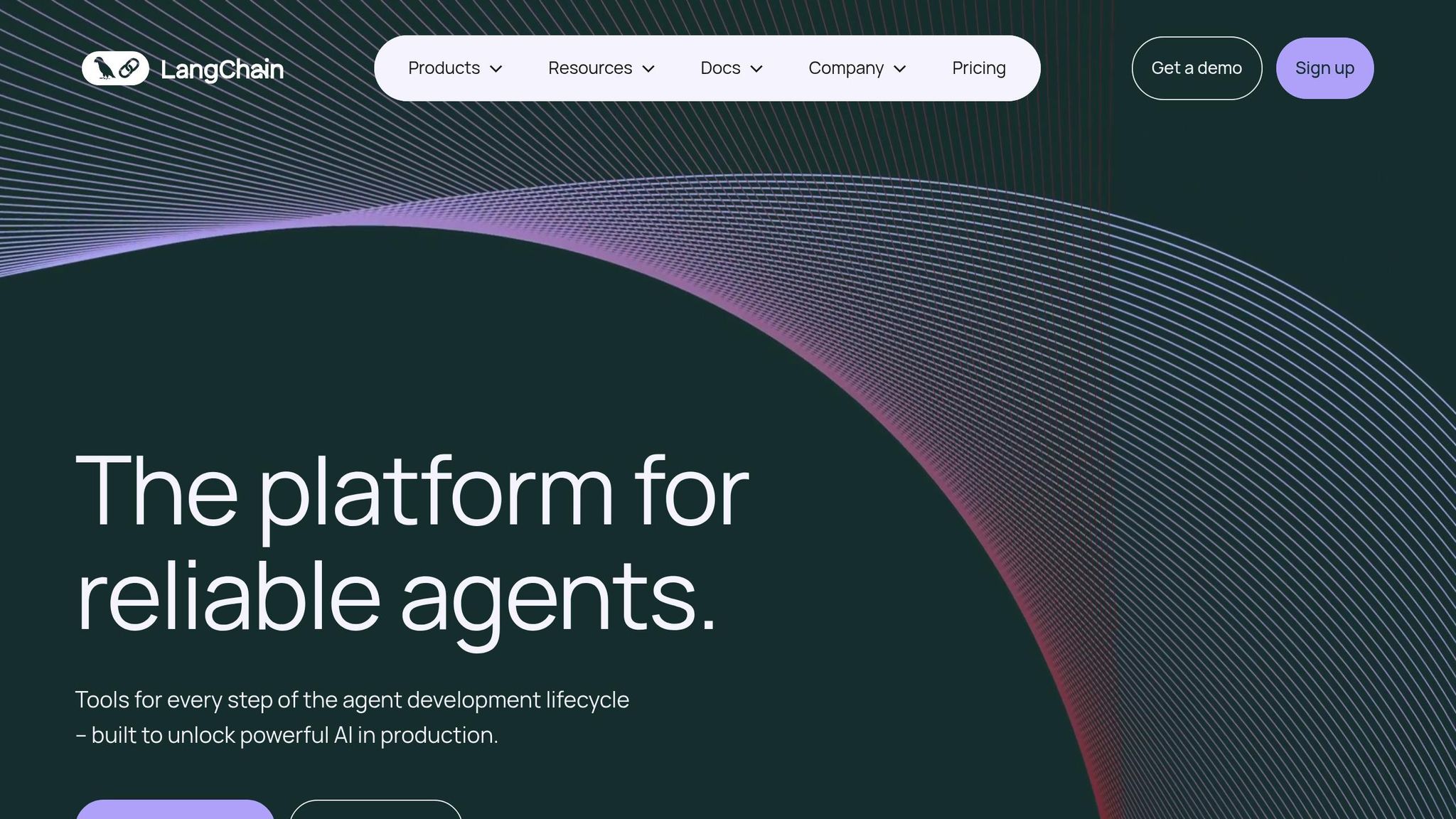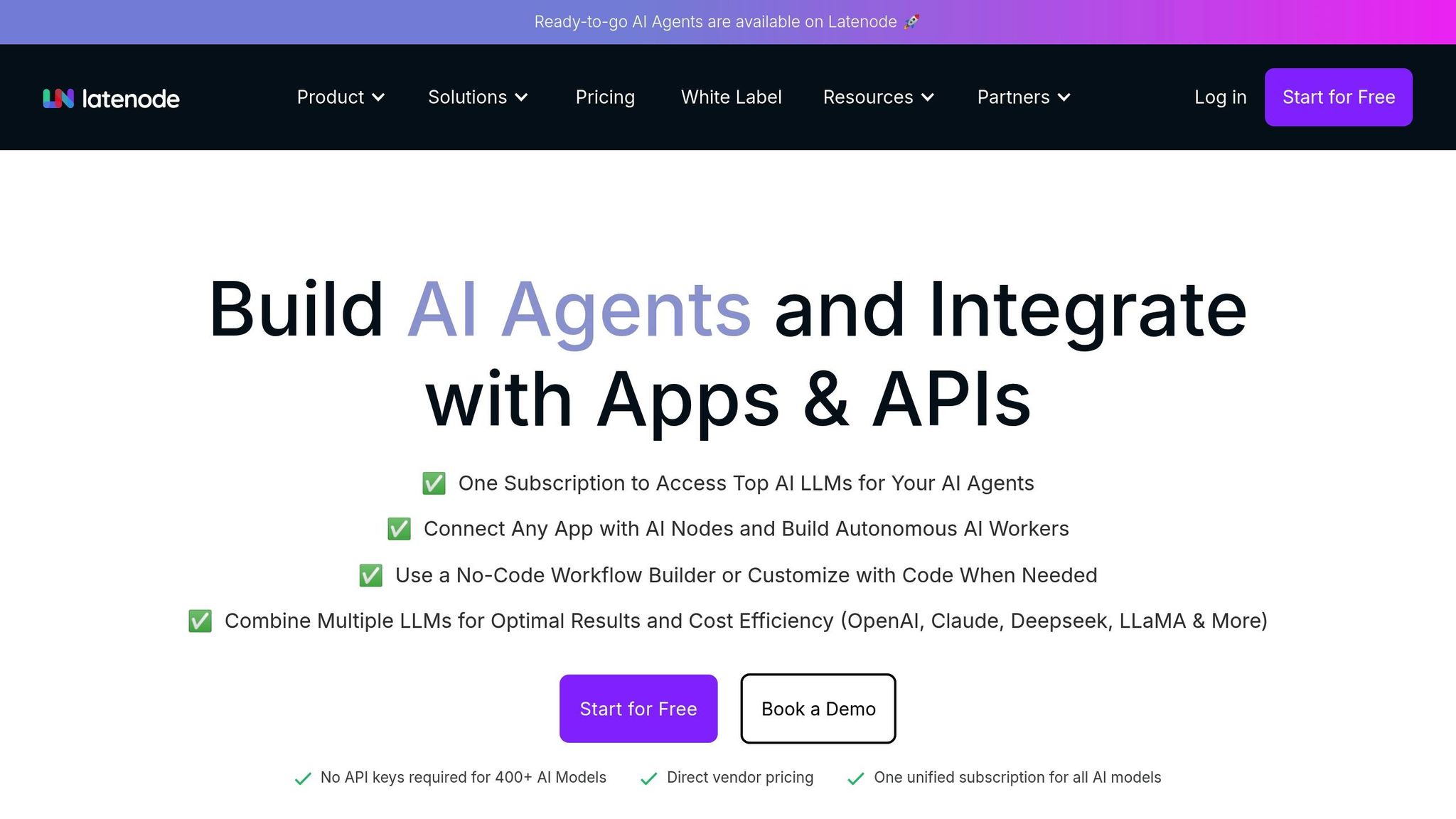


A Retrieval-Augmented Generation (RAG) system combines data retrieval with AI-generated responses, making it ideal for answering questions based on specific documents or datasets. Unlike typical AI models that rely on static, outdated training data, RAG systems dynamically fetch relevant information, ensuring answers are precise and contextually accurate.
For businesses, this means delivering responses grounded in internal policies, workflows, or recent updates - without needing to train a custom model. Tools like Latenode simplify the process, letting you build a RAG system in hours instead of weeks.
Here’s how it works and how you can create your own.

Creating a Retrieval-Augmented Generation (RAG) system requires a solid understanding of the technologies that enable efficient document retrieval and accurate response generation.
At the heart of a RAG system are embeddings, which transform text into numerical vectors that represent its meaning. This allows the system to connect user queries like "What's our refund policy?" to relevant content in your documents, even if the documents use phrases like "return procedures" or "money-back guarantee."
Vector databases play a crucial role by storing these embeddings and enabling quick similarity searches. Unlike traditional databases that rely on matching exact keywords, vector databases identify conceptually related content. This flexibility ensures that users can find the information they need, even when their phrasing differs from the text in your documents.
Language models manage the generation aspect of RAG systems. They take the retrieved context and user queries to generate clear and relevant responses. What sets RAG systems apart from standard AI chatbots is their ability to ground answers in your specific documents, rather than relying solely on pre-trained data.
Chunking strategies are another vital component. This involves dividing your documents into segments for processing. The goal is to strike a balance: chunks that are too large may lose precision, while chunks that are too small might miss important context spanning multiple sentences or paragraphs.
Developing a RAG system typically involves tools like Python, LangChain for workflow orchestration, FAISS or Pinecone for vector storage, and language models from providers such as OpenAI or Hugging Face.
For vector databases, you have options like Pinecone, which offers scalable cloud solutions, or open-source tools like Chroma for local setups. Each has its own setup and configuration process.
Pre-trained language models require API access, and you’ll need to monitor usage carefully, as costs can vary depending on the complexity of the model and the volume of queries.
While traditional RAG development can take weeks to master due to the complexities of vector databases and embedding models, platforms like Latenode simplify the process. Using Latenode’s visual tools, you can build document-based AI systems in just hours with drag-and-drop components.
Once the tools are ready, the next step is to prepare your dataset and outline your system requirements.
The quality of your document selection is critical. Focus on well-organized documents that align with user needs rather than including everything indiscriminately.
Next, text preprocessing ensures your documents are clean and consistent. This step involves removing unnecessary formatting and standardizing the structure for better processing.
From a technical standpoint, you’ll need hardware with at least 8–16 GB of RAM and access to a GPU for efficient embedding generation. Alternatively, cloud-based solutions can handle these tasks, though they come with ongoing costs.
System architecture planning is another key consideration. You’ll need to decide between local deployment, which is ideal for sensitive data, and cloud services, which offer scalability. Factors like data privacy, expected query volume, and maintenance capabilities should guide your decision.
Mastering these foundational concepts and preparations sets the stage for building an effective RAG system. The next steps involve implementing these ideas, starting with document ingestion and preprocessing.
A RAG system transforms documents into a searchable knowledge base by leveraging five essential components.
The process begins with document ingestion, where documents are imported and prepared for vector storage [1].
Document loading handles files like PDFs, Word documents, and plain text. The accuracy of retrieval largely depends on the parsing tool you choose:
After loading, text preprocessing ensures the documents are ready for retrieval. This step involves standardizing formats, removing irrelevant content like headers and footers, and addressing special characters [2][4]. Including error handling and logging during this stage helps catch parsing issues that may signal data quality problems upstream [4]. Retaining metadata is also crucial for effective retrieval.
Once the text is cleaned, the next step is to convert it into embeddings that capture its semantic meaning.
Embedding generation converts the preprocessed text into numerical vectors, enabling the system to grasp the relationships between different pieces of content, even when they use varied terminology.
Choosing the right chunking strategy is key to effective retrieval [4]. Fixed-size chunks often lack coherence and are rarely practical for real-world applications [4]. Instead, focus on creating semantically meaningful chunks that maintain context and can stand alone as independent units. Slight overlaps between chunks can help preserve continuity [4]. Additionally, store metadata such as the source document name, section headings, and other relevant details to enhance retrieval accuracy [4].
Selecting a vector database depends on your needs. Cloud-based options like Pinecone provide scalability, while open-source solutions like Chroma are better for local deployments. These databases store embeddings and enable similarity searches using methods like cosine similarity.
To ensure high-quality data, implement deduplication and filtering. Removing redundant or irrelevant content improves system performance and ensures only valuable information is stored in the vector database [4].
With embeddings and metadata in place, the system is ready to fetch relevant data efficiently.
The retrieval component is responsible for querying the vector database to find contextually relevant information for user questions. It converts user queries into embeddings using the same model as document processing to maintain compatibility.
Similarity search identifies the closest matching document chunks based on vector proximity. To provide comprehensive answers, the system retrieves multiple chunks, balancing relevance with the language model's context window limitations.
Metadata filtering refines search results by narrowing them based on attributes like document properties, creation dates, or content categories. This step improves the accuracy of retrieved information.
Fine-tuning retrieval through optimization is essential. Adjust parameters like the number of retrieved chunks and similarity thresholds, testing with real queries to find the best balance between depth and relevance.
In this step, language model integration combines the retrieved context with user queries to generate accurate and grounded responses. The process involves crafting prompts that include the user’s question and relevant document chunks, guiding the model to base its answer on the provided context.
Prompt engineering is critical to ensure high-quality responses. Prompts should direct the model to cite sources, rely solely on the provided context, and indicate if information is missing.
Managing context size is equally important. Since language models have token limits, prioritize the most relevant chunks by ranking them based on importance. This ensures the system delivers accurate responses without exceeding token constraints.
Finally, response formatting tailors the output to user needs, whether it’s a conversational reply, a bullet-point summary, or a detailed explanation with sources.
Latenode simplifies embedding and response generation with its visual workflow, making it easier to deploy these steps quickly.
Integrating all components into a seamless pipeline ensures smooth query processing. This involves establishing clear data flow between document ingestion, vector storage, retrieval, and response generation.
End-to-end testing validates the entire system using realistic queries. Test with a variety of questions, including factual inquiries, multi-part questions, and edge cases where relevant information may be missing.
To maintain performance, implement monitoring for metrics like response time, retrieval accuracy, and user satisfaction. Logging throughout the pipeline helps pinpoint bottlenecks and areas needing improvement.
Error handling ensures the system can gracefully manage failures or unanswerable queries. This includes fallback responses and clear communication about the system's limitations.
Unlike traditional RAG tutorials that require extensive coding knowledge, Latenode’s visual workflows simplify the learning process. By focusing on practical applications, users can build functional systems in a fraction of the time while gaining hands-on experience with key concepts.
The next step involves applying these principles through real-world examples and exploring how platforms like Latenode can speed up development.

Real-world examples help bring the concept of Retrieval-Augmented Generation (RAG) systems to life, making their functionality and potential much clearer.
Below is a simple Python example that outlines the foundational workflow of a RAG system. This code demonstrates how documents are processed, stored, and queried to generate responses:
import openai
from sentence_transformers import SentenceTransformer
import chromadb
from pathlib import Path
class BasicRAGSystem:
def __init__(self):
self.embedding_model = SentenceTransformer('all-MiniLM-L6-v2')
self.client = chromadb.Client()
self.collection = self.client.create_collection("documents")
def ingest_documents(self, document_path):
# Load and chunk documents
text = Path(document_path).read_text()
chunks = self.chunk_text(text, chunk_size=500)
# Generate embeddings
embeddings = self.embedding_model.encode(chunks)
# Store in vector database
self.collection.add(
embeddings=embeddings.tolist(),
documents=chunks,
ids=[f"chunk_{i}" for i in range(len(chunks))]
)
def retrieve_and_generate(self, query):
# Retrieve relevant chunks
query_embedding = self.embedding_model.encode([query])
results = self.collection.query(
query_embeddings=query_embedding.tolist(),
n_results=3
)
# Generate response with context
context = "".join(results['documents'][0])
prompt = f"Context: {context}Question: {query}Answer:"
response = openai.ChatCompletion.create(
model="gpt-3.5-turbo",
messages=[{"role": "user", "content": prompt}]
)
return response.choices[0].message.content
This example showcases the essential steps: document ingestion, storage in a vector database, and generating responses using contextual information. However, enterprise-level implementations often introduce additional challenges.
When scaling RAG systems for enterprise applications, the process becomes more intricate. These setups may include multi-tenant document storage, metadata filtering, caching mechanisms, and monitoring tools. Managing these components often requires collaboration across multiple teams and a significant amount of technical expertise.
This is where Latenode stands out. By offering a visual, no-code approach, it simplifies these complexities, allowing developers to focus on system design rather than infrastructure.
Latenode transforms the traditionally complex RAG setup into a streamlined process. It automates tasks like document chunking and embedding generation as soon as files are uploaded [6][7]. This visual-first approach eliminates many of the pain points associated with traditional RAG systems.
As the Latenode team aptly puts it:
"If you can upload a file and connect two nodes, you can build a RAG-powered AI agent" [6][7].
This simplicity removes the need for external vector databases, manual chunking of documents, and intricate service integrations. Instead, developers can focus on building and iterating.
Here’s how it works with Latenode:
This workflow drastically reduces setup time, enabling developers to prioritize learning and refining RAG concepts instead of dealing with infrastructure headaches.
A developer shared their experience:
"I use Latenode for my RAG workflows. It handles data preprocessing, connects to vector stores, manages embedding model API calls, and chains it all together. I can focus on understanding concepts instead of fighting infrastructure" [5].
The contrast between traditional code-based RAG development and Latenode's visual workflows is striking. Here's a side-by-side comparison:
| Aspect | Traditional Code-Based RAG | Latenode Visual Workflow |
|---|---|---|
| Setup Time | Days to weeks | Minutes |
| External Dependencies | Requires vector databases, embedding APIs, and storage solutions | None |
| Technical Knowledge | Requires programming skills | No programming required |
| Configuration | Manual setup | Automatic processing |
| Accessibility | Limited to technical teams | Open to non-technical users |
| Maintenance | Ongoing management of infrastructure | Platform handles updates |
Feedback from early adopters highlights the time savings, with tasks that once took days now completed in minutes [6][7].
Once a functional RAG (Retrieval-Augmented Generation) prototype is in place, the focus naturally shifts to refining its performance and preparing it for production. Moving from a prototype to a production-ready system involves tackling performance challenges and building a scalable, reliable architecture.
The performance of a RAG system hinges on the efficiency of its retrieval, embedding, and response generation processes. Each of these components can be fine-tuned to ensure the system operates smoothly.
Optimizing Retrieval: Selecting the right embedding model is critical. While general-purpose models like all-MiniLM-L6-v2 are suitable for early stages, domain-specific models often provide 15–20% better accuracy. For example, technical documentation retrieval often benefits from models such as sentence-transformers/multi-qa-mpnet-base-dot-v1.
Chunking documents into segments of 256–512 tokens with slight overlaps helps maintain context while improving retrieval accuracy. For more complex documents, like legal texts, larger chunks of 800–1,000 tokens may be necessary to preserve the integrity of the information.
Improving Vector Database Performance: As the system scales, vector database efficiency becomes a priority. Algorithms like HNSW (Hierarchical Navigable Small World) can reduce query times to milliseconds. Additionally, incorporating metadata filtering allows for precise retrieval without compromising speed.
Streamlining Response Generation: Prompt optimization can significantly reduce token usage - by as much as 30–40% - while maintaining response quality. Using faster models for basic queries and reserving advanced models for complex tasks ensures efficiency. Caching frequently accessed embeddings and responses with tools like Redis can cut response times by up to 80%, especially for repeated queries.
Deploying a RAG system in a production environment requires careful planning, with attention to monitoring, error management, and scalability.
Infrastructure Design: To prevent bottlenecks, separate key components. For instance, document processing should be isolated from query handling. Load balancers can distribute traffic evenly, while dedicated workers manage document updates.
Monitoring and Observability: Keeping the system healthy requires tracking metrics like retrieval latency, embedding generation time, and response quality. Alerts for issues such as query failure rates above 1% or response times exceeding 3 seconds help address problems before they affect users.
Error Handling: Production systems must be prepared for failures. If a vector database becomes unavailable, fallback mechanisms should ensure the system degrades gracefully rather than failing entirely. Circuit breakers can also prevent cascading failures across interconnected services.
Security Measures: Protecting the system and its data is crucial. Implement document access controls, API rate limits, and input sanitization to guard against misuse. Encrypting stored embeddings adds another layer of protection for sensitive information.
Version Control: Managing updates safely is essential. Versioning both models and document collections allows for smooth updates and rollbacks. Blue-green deployment strategies enable testing new configurations without disrupting users.
Scaling a RAG system to meet production demands can be complex, but platforms like Latenode simplify the process. Traditional scaling often involves juggling multiple services, databases, and APIs, but Latenode's visual workflows and built-in tools streamline these tasks.
Automatic Scaling: Latenode adjusts to traffic demands without manual intervention. Whether processing one query or thousands, the platform ensures consistent performance. Its parallel execution capabilities support up to 150+ concurrent processes on Enterprise plans, maintaining reliability even under heavy loads.
Integrated Monitoring: Real-time insights into workflow performance are available without additional setup. Latenode tracks execution times, success rates, and resource usage, making it easy to identify and fix underperforming workflows. Features like execution history and scenario re-runs further simplify debugging and optimization.
Simplified Version Management: Latenode's visual interface makes version control straightforward. Teams can create, test, and roll back workflow versions instantly, eliminating the need for complex deployment pipelines.
Cost Efficiency: Latenode's execution-based pricing model ensures you only pay for actual processing time, potentially reducing infrastructure costs by 40–60% compared to traditional always-on server setups.
Flexible Integrations: As requirements evolve, Latenode adapts without requiring major architectural changes. Adding data sources, switching AI models, or introducing new processing steps is as simple as updating visual workflows. With support for over 300 app integrations, the platform fits seamlessly into existing systems.
Creating a Retrieval-Augmented Generation (RAG) system involves mastering several components: document ingestion, vector storage, retrieval mechanisms, and response generation. The true challenge lies in scaling these processes for production environments.
This guide has walked through the foundational steps for building a functional RAG system, from preprocessing documents and generating embeddings to integrating a retrieval component with language models. A few critical points to keep in mind include:
Traditional RAG development can be time-consuming, often taking weeks to complete. However, using structured approaches and advanced tools can dramatically shorten this timeline. Platforms that provide pre-built components and visual development tools simplify tasks like managing vector databases, embedding models, and scaling infrastructure.
If you're looking for a more efficient way to develop RAG systems, consider Latenode. While this guide offers the groundwork for building RAG systems with code, Latenode offers a visual platform that accelerates development without compromising functionality.
Latenode combines document processing, vector storage, and API orchestration into an intuitive drag-and-drop interface. Its AI-native design supports seamless integration with models like OpenAI, Claude, Gemini, and custom options, all through structured prompt management. This eliminates the need to build custom API wrappers, saving time and effort.
With over 300 app integrations and compatibility with more than 1 million NPM packages, Latenode allows you to connect existing data sources and extend your system's capabilities without writing extensive boilerplate code. The platform also supports automatic scaling, handling up to 150+ parallel executions on Enterprise plans. This ensures consistent performance, whether you're processing one query or thousands.
Latenode's built-in database, execution history, and visual interface streamline version control and make it easy to roll back workflows without complex deployment pipelines.
Explore proven RAG patterns and tutorials - start Latenode's comprehensive learning path today and take your RAG system development to the next level.
A Retrieval-Augmented Generation (RAG) system stands out by addressing document-based queries in a way that surpasses traditional AI models. While conventional models rely solely on pre-trained data, RAG systems actively retrieve relevant external information during the response process. This dynamic approach ensures responses are not only more accurate but also reflect the most current data available.
What makes RAG systems particularly appealing is their ability to connect with real-time or specialized data sources. This feature is especially valuable for industries where precision and up-to-date information are critical, such as healthcare, finance, or legal research. By incorporating this retrieval mechanism, RAG systems also improve clarity and perform exceptionally well in domain-specific contexts. This makes them a versatile choice for applications ranging from customer service to in-depth research tasks.
Latenode simplifies the creation of RAG (Retrieval-Augmented Generation) systems by eliminating the need for complicated setups, such as configuring external vector databases. Instead, it offers a low-code platform with a visual workflow builder that lets you design and deploy intelligent RAG systems in just minutes. What once took weeks can now be accomplished in a matter of hours.
The platform is designed to make advanced AI capabilities accessible to everyone. Its intuitive interface removes technical hurdles, allowing even beginners to build, test, and manage RAG workflows with ease. At the same time, it provides the power and functionality needed for enterprise-level projects - all without requiring deep coding knowledge or prior technical expertise.
When deploying a Retrieval-Augmented Generation (RAG) system into production, there are several critical factors to keep in mind to ensure smooth operation and reliability:
It's also important to think ahead. Design your system to be flexible and capable of adapting to future demands. Effective data management and continuous monitoring play a vital role in maintaining the system's reliability and ensuring it operates efficiently in a production setting.



